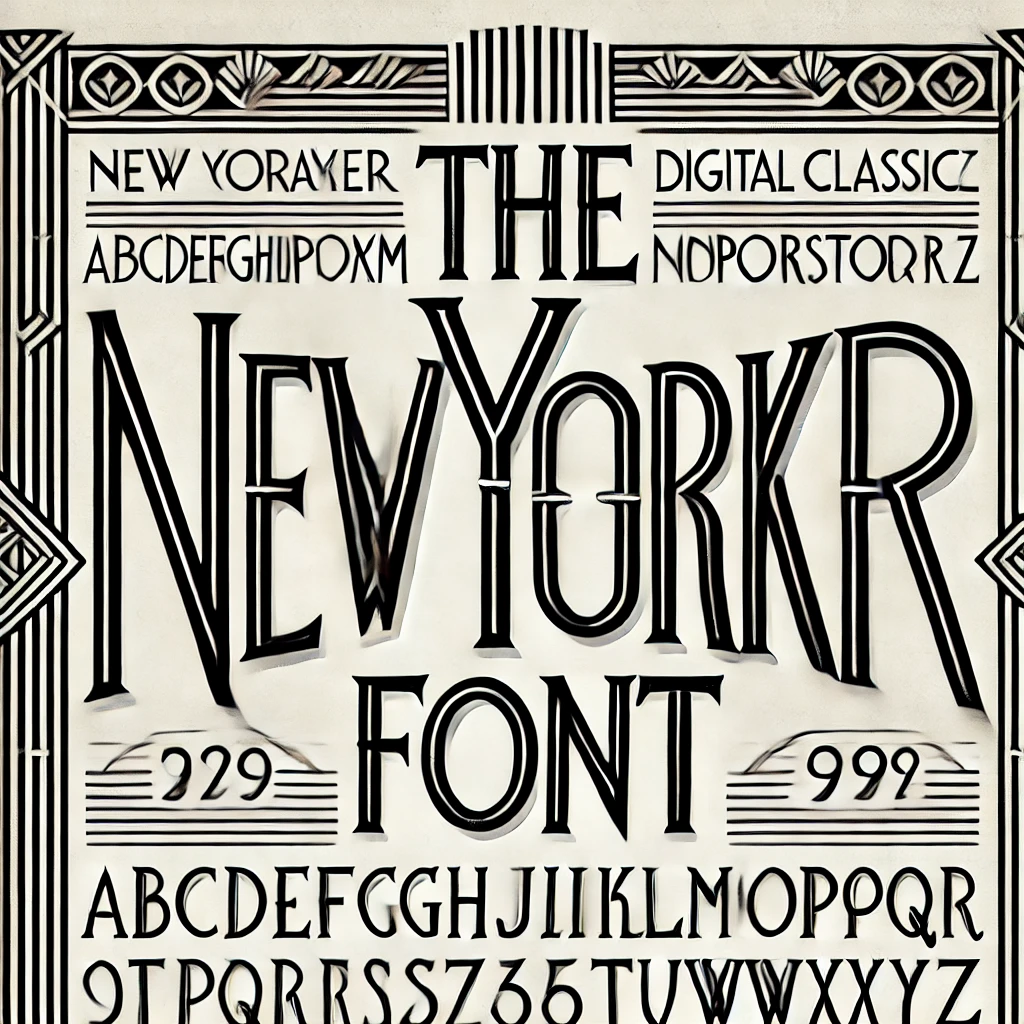The New Yorker font defines the magazine’s visual identity with its distinctive lettering style. The lettering of this font develops a link to sophistication and journalism alongside artistic expression. The typeface appears in digital or print media to communicate the primary identity of the magazine while immediately engaging its audiences.
Overview of The New Yorker Font
The New Yorker magazine font, Irvin, is the signature typeface used for its brand title and main headline display typography. First art director Rea Irvin created this font for The New Yorker which delivers distinctive hand-drawn features suitable for the magazine’s editorial approach. The artistic letters with slender forms and decorative elements distinguish this typeface as a distinctive member of traditional typefaces.
History of The New Yorker Font
The origin of The New Yorker font exists closely with the inception of the magazine itself. The New Yorker began its publication under Harold Ross’s leadership in 1925 while Rea Irvin served as the responsible party for establishing the magazine’s visual identity through typography. Because of its designer’s creation The New Yorker magazine gained its distinct brand identity which combined refined elegance and playfulness.
The typographic design of Irvin drew inspiration from the bestselling Art Deco trend in the early part of the twentieth century. The letter combinations feature distinctive, elaborated serifs which capture Art Deco sophistication and the extended letterforms make the font easily readable yet unique.
Features of The New Yorker Font
- Art Deco Influence
The New Yorker font captures Art Deco style through its vertical and dignified letter designs as well as its minimal rounded shapes and its elaborated finishing strokes.
- Hand-Drawn Elegance
The New Yorker font contains a distinct visual charm because of its unfinished hand-written style that diverges from standard serif fonts.
- High Contrast Lettering
The New Yorker font contains a distinct visual charm because of its unfinished hand-written style that diverges from standard serif fonts.
- Elongated and Narrow Design
Its elongated narrow design allows Citieswide National Bank to stand out visually through headlines and titles while delivering a high-end appearance.
- Distinctive Serif Detailing
The serifs in The New Yorker font are not conventional; they have a slightly decorative, almost whimsical quality that adds to the magazine’s character.
The New Yorker Font Free Download
You can download this font by clicking the link given below.
Applications of The New Yorker Font
- Magazine and Editorial Design
The font is perfect for editorial layouts, magazine covers, and article headlines, thanks to its elegance and readability.
- Luxury Branding and Packaging
Luxury brands pursuing a classic vintage aesthetic usually select fonts designed with inspiration from The New Yorker typography.
- Event Invitations and Posters
Art Deco-themed invitations, theater posters, and event branding benefit from the font’s timeless and artistic look.
- Logo and Identity Design
Businesses that want to convey a refined, intellectual, or artistic identity may use fonts similar to The New Yorker for their logos.
- Book Covers and Publishing
The font’s unique letterforms make it an excellent choice for book covers, poetry collections, and literary works that require a distinctive yet elegant typeface.
Alternatives to The New Yorker Font
The designer community frequently seeks alternatives to the custom-made original New Yorker font because the public cannot obtain it. The following list contains fonts that have a close resemblance to The New Yorker typeface:
1.New Yorker Type
- Created by Gert Wiescher, this font closely replicates the original New Yorker typography.
- Best used for magazine-style designs and vintage branding.
- Some versions of the Irvin font family capture the style of The New Yorker’s lettering.
- Good for elegant and high-end designs.
- A refined serif font with high contrast, similar to The New Yorker typeface.
- Suitable for luxury branding and elegant editorial work.
- A fashion-inspired serif font that mimics the sophistication of The New Yorker font.
Ideal for invitations, logos, and advertising.
How to Use The New Yorker Font Effectively
If you’re using an alternative font that resembles The New Yorker typography, here are some design tips to make the most of it:
- Pair it with a Clean Sans-Serif Font
Since The New Yorker font is highly decorative, pairing it with a clean sans-serif font like Futura or Helvetica can balance your design.
- Use it for Headlines and Titles
This typeface works best when used for titles, headlines, and branding elements, rather than body text, where readability may be an issue.
- Stick to a Classic Color Palette
Black-and-white or neutral tones complement the vintage and sophisticated feel of The New Yorker font.
- Maintain Generous Spacing
To enhance legibility and elegance, ensure that the letter spacing (kerning) is well-adjusted for a clean and refined look.
Read more: Persona 5 Font: Free Download
Conclusion
The New Yorker font represents much more than a generic typeface design as it embodies both sophistication and elegant artistry, and everlasting design quality. Art Deco elements lead to the creation of this font which now symbolizes the premium standards of literary publications and artistic advancements.
Different alternatives to the original typeface grant designers the chance to convey its specific essence when creating their projects, although the authentic font resides exclusively with the magazine. Designers can achieve elegant distinction in their projects by using typefaces that resemble The New Yorker font, regardless of whether they work with magazines or luxury brands, or Art Deco designs.
